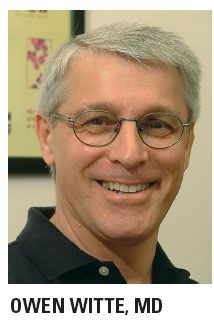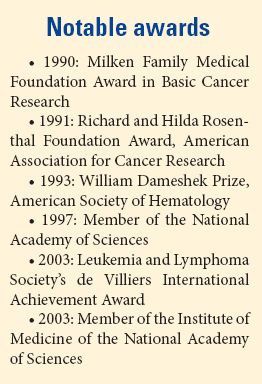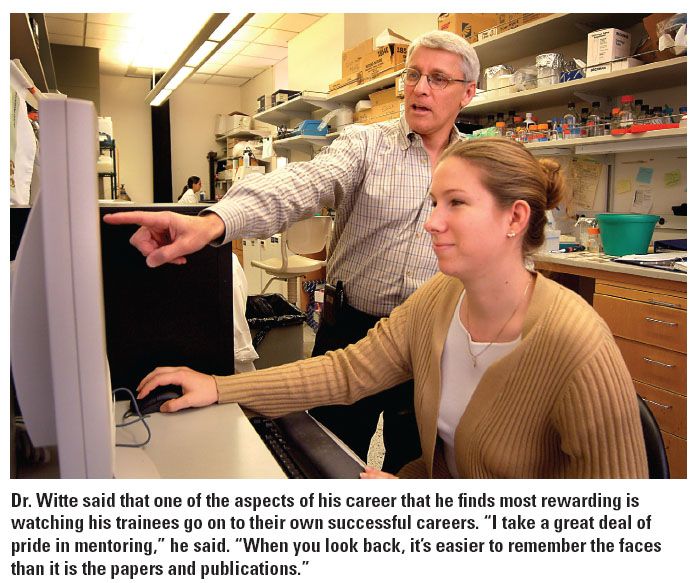Moving at the speed of science
Owen Witte, MD, has been a California resident for nearly 35 years, but there’s nothing laid-back about him. The director of the Eli and Edythe Broad Center of Regenerative Medicine and Stem Cell Research retains the rapid fire speech of a native New Yorker. Although it was getting toward late afternoon when Dr. Witte met with Oncology News International, he ushered a steady stream of visitors into and out of his office at the University of California, Los Angeles. When he spoke about his work, it was with the same energy that no doubt drew him to science in the first place.
Owen Witte, MD, has been a California resident for nearly 35 years, but there’s nothing laid-back about him. The director of the Eli and Edythe Broad Center of Regenerative Medicine and Stem Cell Research retains the rapid fire speech of a native New Yorker. Although it was getting toward late afternoon when Dr. Witte met with Oncology News International, he ushered a steady stream of visitors into and out of his office at the University of California, Los Angeles. When he spoke about his work, it was with the same energy that no doubt drew him to science in the first place.

“I had wonderful science teachers in elementary school. In sixth grade, my teacher recommended a book called Microbe Hunters,” Dr. Witte explained. “It’s a story of the great discoveries of microbiology. It was like the CSI of its day. I got turned on to microbiology.”
What followed was a career with many milestones in hematology and cancer care, including breakthroughs in the treatment of chronic myelogenous leukemia (CML). Now as the director of one of the country’s premier stem cell research institutes, Dr. Witte is working in an area that is rapidly advancing and, no surprise, he has no qualms about keeping up.
“This is an exciting area of science,” he said. “There is no field of medicine that can’t somehow involve the study of stem cells.”
Great mentors, great friends
Dr. Witte graduated from Cornell University in New York with a bachelor of science in microbiology, and he went on to earn his medical degree at Stanford University in Stanford, Calif., in 1976. He completed postdoctoral fellowships under the tutelage of Irving L. Weissman, MD, at Stanford and David Baltimore, PhD, at the Massachusetts Institute of Technology in Boston. Dr. Weissman is the director of the Institute of Stem Cell Biology and Regenerative Medicine. Dr. Baltimore won the 1975 Nobel Prize in Physiology or Medicine for his research in virology.
“Both of them made a huge impact in my life, personally and scientifically,” Dr. Witte said. “They are phenomenally successful scientists. They are very different people, but they both have a relentless drive to answer the question. Whatever they are confronting, they will stop at no obstacles, recruit the best people, never hesitate to use new technology, and go after the answer. That’s what I’ve learned from them.”

During his postdoctoral fellowships, Dr. Witte had what he considers one of the seminal moments in his career: Discovering that phosphotyrosine is the end product of a kinase reaction. “That was a major lightbulb moment,” he said.
The road to Gleevec
Dr. Witte joined UCLA’s department of microbiology and molecular genetics in 1980. Like many young people at a first job, he assumed that he’d only stay a few years. While UCLA offered him the opportunity to handle heady matters in the lab, something a little more earthly kept him around.
“I met my wife, Jami McLaughin Witte, about the fifth day I was in L.A.,” he said. “Jami has worked with me for 20-plus years and is actually responsible for some of the really important work that I receive a lot of credit for!” Ms. McLaughin Witte is a research assistant in the UCLA department of microbiology, immunology, and molecular genetics.
Two of the important discoveries were the BCR-ABL oncogene and the Philadelphia chromosome abnormality, both associated with CML. Then there was the “big one” that led to the development of imatinib (Gleevec). “With that particular discovery, it was very clear that we were on to something major,” Dr. Witte said.
“At the time, my graduate student, James Konopka, was working on a different question: He was looking at human leukemia cell lines. He observed that in human CML, we consistently saw this unexpectedly large and highly active tyrosine kinase. We already knew from our studies on a related mouse gene that that was sufficient to cause transformation. We had a unique molecular signature and a consistent pattern associated with a specific disease. It was clear as a bell: That was the cause of CML.”
“I went around to every drug company and told them about what we’d found. They said ‘That’s great, but we can’t make inhibitors of tyrosine kinase.’ Fortunately, they were able to work that out!” Dr. Witte said. In October 2009, Gleevec was awarded the Prix Galien USA for best pharmaceutical product.
New explorations
Dr. Witte is not one to rest on his laurels. His continued drive is evident by his professional titles: Besides founding and directing the stem cell research institute, he is a professor of microbiology, immunology, and molecular genetics and holds the David Saxon Presidential Chair in Developmental Immunology at UCLA. He is also a professor of molecular and medical pharmacology at UCLA’s David Geffen School of Medicine. Finally, he is an investigator with the Howard Hughes Medical Institute. In recent years, Dr. Witte has expanded his areas of interest to include molecular imaging, molecular gene therapy, and cancer treatment via the immune system.
“What we are trying to do is arm the immune system with a T-cell receptor that we can transplant into stem cells or lymphocytes to imbue them with the characteristics of anti-cancer,” he explained. “In this case, we are using a T-cell receptor that reacts with an antigen found in human melanoma. We’re actually in clinical trials with this. We have a group, the Immune Therapy Consortium, utilizing this concept.”
Dr. Witte has also been involved in tracking the molecular basis of prostate cancer. “Almost all of the current therapies are based on surgical excision or ablation of the androgen reception function. We think we have to find new places to attack that disease,” he said.
One point that Dr. Witte emphasizes as director is the importance of multidisciplinary work: His community of researchers will produce the results that community oncologists and hematologists need to treat patients.
“We are trying to understand the fundamental nature of cells that continually repopulate a cancer even after we hit it hard with chemotherapy or radiotherapy,” he said. “We are working to define the pathways that make cancers grow and to see how we can use the natural stem cells of the body, like those of the immune system, to arm the body with a new sense of urgency to kill off cancer.”

‘Good science always benefits society’
For many people, stem cells are not merely a scientific issue, but a personal, political, and emotional one. Dr. Witte pointed out that stem cell-based science does not automatically mean embryonic stem cells.
“The embryonic stem cells still retain certain controversy to them, but studying embryonic stem cells is very expensive,” he said. “Most of the research that goes on in stem cell research is not controversial at all; it involves tissue-specific stem cells from adult organs or it’ll involve certain animal models.”
In early 2009, President Barack Obama signed an executive order that reversed an embryonic stem cell funding ban. Nearly a decade ago, former President George W. Bush limited the use of taxpayer money to only the 21 stem cell lines that had been produced before his decision. The Obama order reserved that ban but did not affect another legislative ban that precluded federal money paying for the development of stem cell lines.
“I was delighted that the President reversed some of the onerous previous restrictions,” Dr. Witte said. “I think he needs to go further. I think the NIH needs to reinvestigate their current restrictions on stem cell research. It’s become a bit easier to receive federal money for studies, but there are inconsistencies between some aspects of federal law, NIH restrictions, and various state guidelines that still need to be worked out.”
While stem cells may always engender controversy, the science will speak for itself. “I think it’s important to do science at the highest quality level. Good science always benefits society,” he said.
Breaking down barriers
When asked what he is most keen on achieving with his directorship, Dr. Witte is quick with a reply: “What I view as really important is to encourage younger scientists to do work not only in their area of expertise that is lab-based, but to reach out to other colleagues in clinical divisions or specialty technology areas.”
At the institute, Dr. Witte has created specialized facilities for growing and handling stem cells. There is also the FDA-compliant Good Manufacturing Practice facility, in collaboration with the Jonsson Comprehensive Cancer Center, which ferries translational research to the clinic.
“My goal is to take down the barrier that young scientists might face as they try to take their idea from bench to bedside,” he said.